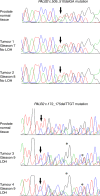PALB2 mutations and prostate cancer risk and survival
- PMID: 34006922
- PMCID: PMC8368211
- DOI: 10.1038/s41416-021-01410-0
PALB2 mutations and prostate cancer risk and survival
Abstract
Background: The objective of this study was to establish the contribution of PALB2 mutations to prostate cancer risk and to estimate survival among PALB2 carriers.
Methods: We genotyped 5472 unselected men with prostate cancer and 8016 controls for two Polish founder variants of PALB2 (c.509_510delGA and c.172_175delTTGT). In patients with prostate cancer, the survival of carriers of a PALB2 mutation was compared to that of non-carriers.
Results: A PALB2 mutation was found in 0.29% of cases and 0.21% of controls (odds ratio (OR) = 1.38; 95% confidence interval (CI) 0.70-2.73; p = 0.45). PALB2 mutation carriers were more commonly diagnosed with aggressive cancers of high (8-10) Gleason score than non-carriers (64.3 vs 18.1%, p < 0.0001). The OR for high-grade prostate cancer was 8.05 (95% CI 3.57-18.15, p < 0.0001). After a median follow-up of 102 months, the age-adjusted hazard ratio for all-cause mortality associated with a PALB2 mutation was 2.52 (95% CI 1.40-4.54; p = 0.0023). The actuarial 5-year survival was 42% for PALB2 carriers and was 72% for non-carriers (p = 0.006).
Conclusion: In Poland, PALB2 mutations predispose to an aggressive and lethal form of prostate cancer.
© 2021. The Author(s), under exclusive licence to Springer Nature Limited.
Conflict of interest statement
S.N. is an editorial board member for the
Figures


References
Publication types
MeSH terms
Substances
LinkOut - more resources
Full Text Sources
Other Literature Sources
Medical
Research Materials
Miscellaneous

